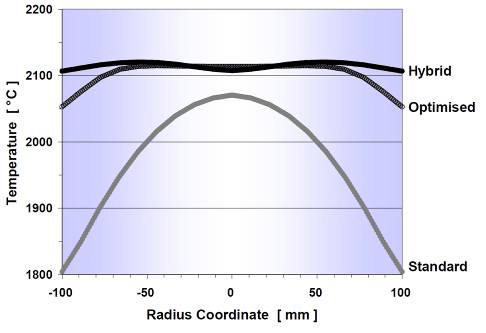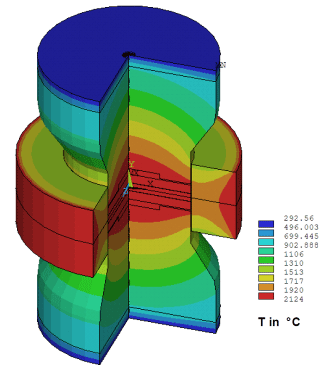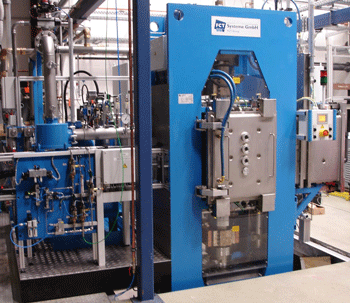2010 Hagen Symposium Reports: Improved material properties with short-time sintering
Sintering is the transformation of a powder compact into a technical product with functional properties via the creation of firm metallurgical bonds between separate powder particles. This is achieved by heating the compacts to a temperature below the melting point of the main constituent of the alloy so that the mobility of the atoms is sufficiently high to create these bonds. Frequently, the sintering process is accompanied by a densification of the compact. This can be supported by external pressure, either by gas (Sinter-HIP) or in a rigid tool set (hot pressing).
Conventional pressureless sintering processes are carried out in a continuous or batch type furnace. They need long times to heat the compacts to the sintering temperature, a dwell time at temperature and a cooling period. The heat transfer into the compacts is usually accomplished by convection at low temperatures and increasingly by radiant heat at higher temperatures. Both types of heat transfer increase the temperature at the surface of the compacts and the heat transfer from the surface to the interior is accomplished by heat conduction. This is a time consuming process.
An undesirable side effect at high temperatures can be grain growth which is particularly detrimental for the sintering of nanostructured materials. Candidates for short-time sintering processes are therefore specially nanostructured aluminium alloys, ultra fine-grained hardmetals and ceramics (A previously published ipmd.net report on nanostructured materials is available containing more information on this).
Fig. 1 Finite element simulation of FAST/SPS processing
of a hardmetal disc at 2100°C (courtesy FCT)
Spark plasma sintering (SPS) was the initial innovation for short-time sintering processes with strict control of grain growth. Like conventional hot pressing, it is carried out in a closed die under uniaxial pressure, but the compact is not heated by a steady current. Instead, a spark plasma is generated between the particle contacts by a pulsed DC electric field which can create local temperatures far above the melting point of the alloy for extremely short times.
The spark discharge, which is only active at the particle surfaces, does not affect the interior of the particles. It leads to the growth of sinter necks without grain growth inside the powder particles.
Based on SPS technology, several approaches to realise shorter sintering cycles have been developed by FCT in addition to conventional pressureless sintering, gas pressure assisted sintering (Sinter-HIP) and hot pressing in a die.
The pressureless sintering process ‘FAST-Sint’ is a fully automated manufacturing unit with a heating cell that can be specially tailored for a specific part. Each part is sintered individually so that the heated mass is extremely small. Depending on material and size of the components heating rates of 1000 K/min and cycle times of 1 minute or less can be achieved. As soon as the sintering temperature is reached, the field is switched off and the part is cooled down. The FAST-Sint cell can be operated in vacuum or protective gas. Even the application of a gas pressure of 60 bar, for example, is possible if required.

Fig. 2 Temperature uniformity in a standard tool, optimised and with hybrid heating, computer simulation (courtesy FCT)
The FCT approach for a shorter sintering cycle in comparison to hot pressing combines SPS technology with an additional inductive heating of the tooling. It is called hybrid heating by ‘Field Assisted Sintering Technique’ (FAST/SPS). It further improves the temperature uniformity in the material and reduces the time required for sintering. Fig. 1 shows the temperature distribution in a tool during sintering of hardmetal at 2100°C as calculated by finite element computer simulation in a coloured display. Fig. 2 shows the temperature distributions in a standard tool, after optimisation of the tooling and with hybrid heating FAST/SPS. An industrial furnace for this technology is shown in Fig. 3.
The development of ultra fast ‘FAST²’ sintering technology for the production of small parts with a relatively simple geometry in high numbers is still in progress. The idea is to be able to sinter on-line with a powder press. FCT develops integrated press-and-sinter equipment which can sinter compacts in just seconds.
The process involves heating by a direct current in a special, firmly installed tooling. Power electronics and the necessary measurement and control technology achieve heating rates of several thousand degrees per minute.
These new short-time sintering processes can offer cost-effective manufacturing of PM parts with special material properties that cannot be realized by conventional sintering. www.fct-systeme.de
News | Articles | Market reviews | Search directory | Subscribe to e-newsletter







